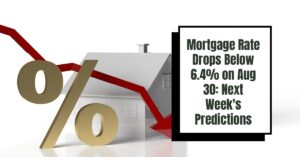Mortgage rates have just made a significant shift, with the average interest rate for a standard 30-year fixed mortgage dipping below 6.4%, specifically to 6.38% as of today, August 30, 2024. This change, though seemingly subtle, is a break from the high rates that have plagued buyers and homeowners alike over the past few years. The reduction in mortgage rates offers a glimmer of hope for potential homebuyers, those looking to refinance, and anyone keeping an eye on the housing market.
Mortgage Rate Drops Below 6.4% on Aug 30: Next Week's Predictions
Key Takeaways:
- Current Average Mortgage Rates:
- 30-year fixed-rate: 6.38% (down 0.11%)
- 15-year fixed-rate: 5.76% (down 0.08%)
- Jumbo 30-year fixed-rate: 6.57% (down 0.08%)
- 5/1 ARM: 6.09% (no change)
- Refinance options: 30-year fixed-rate refinance at 6.35% (down 0.10%)
- Factors Influencing Rates:
- Decrease attributed to lower inflation and signs of a weakening labor market.
- Anticipated Federal Reserve interest rate cuts set for September.
- Future Predictions:
- Economists predict a gradual decline in rates over the coming year.
- Prospective homebuyers may return, but the housing market's affordability remains a concern.
As someone who closely follows the mortgage and housing markets, the impact of mortgage rates on buyer sentiment is undeniable. When rates drop, it invariably sparks interest among those hesitating to enter the market. But this interest comes against the backdrop of persistent affordability issues, which complicates the situation.
Current Mortgage Rates Overview
This week's Bankrate data shows the following rates for August 30, 2024:
- 30-year fixed-rate: 6.38%, down 0.11% from the previous week.
- 15-year fixed-rate: 5.76%, down 0.08%.
- 30-year fixed-rate jumbo: 6.57%, down 0.08%.
- 5/1 ARM: Stays steady at 6.09%.
- Refinance options: 30-year fixed-rate refinance at 6.35%, down 0.10%.
These numbers reflect a broader trend that began in early August when mortgage rates saw substantial reductions due to concerns regarding labor market health, prompting fears of an impending recession. The downward trajectory of mortgage rates typically signals a loosening of financial conditions, making it an ideal time for many buyers to consider entering the market.
Economic Influencers on Mortgage Rates
The relationship between mortgage rates and economic indicators cannot be understated. Mortgage rates are highly sensitive to inflation and employment data, both of which guide the Federal Reserve's monetary policy. In recent months, we have observed inflation rates cooling to their lowest levels since Spring 2021. This shift has led many experts to believe that the Fed will initiate its first interest rate cuts during its September meetings.
From my perspective, this anticipated cut is crucial. Improved economic signals often encourage more buyers to enter the market, bolstered by lower financing costs. However, it's important to understand that even as mortgage rates decrease, substantial barriers to homeownership persist. The current housing market's prices continue to reflect a reality where many potential buyers find homes unaffordable — a situation that a slight decrease in mortgage rates alone cannot remedy.
What to Expect Moving Ahead
Looking ahead to 2024, the outlook on mortgage rates remains optimistic but cautious. Many economists and housing market analysts believe that while rates will continue to fall, it may not be a swift journey back to historic lows experienced in the early 2020s when rates hovered around 2% to 3%. The consensus suggests that we may see rates settle just above 6.0% by the end of the year.
Several prominent predictions suggest that the 30-year fixed-rate mortgage could average around 6.4% by the year's end, despite fluctuations. For example, Fannie Mae recently revised its earlier predictions, looking for rates to stabilize around this figure in the final quarter. Reliable analyses from sources like Forbes and NAR also affirm this prediction, reinforcing what appears to be a gradual recovery toward more favorable financing options for homebuyers.
In a setting characterized by these adjustments, I find it interesting how buyers respond. Lower rates can incite enthusiasm, but will that lead to increased activity in a market still laden with high prices? History suggests that many buyers will bide their time, waiting for the perfect moment to act.
The Housing Market's Recovery Gears Up
Despite the positive news surrounding mortgage rates, it’s worth noting that many potential buyers remain watchful. Personal experience has shown that significant shifts in mortgage rates often don't translate to immediate reactions in home buying activity, especially since home prices have not significantly dropped in response to rate reductions.
The housing market's recovery appears to hinge not solely on mortgage rates but also on broader economic factors, including:
- Consumer Confidence: With a culture steeped in cautious economic outlooks, many first-time homebuyers still question whether now is the right time to purchase.
- Home Prices: Even with lower interest rates, elevated home prices challenge buyers, particularly first-time owners.
- Inventory: The availability of homes on the market plays a critical role. As prices stabilize and rates fall, inventory levels may dictate how quickly the market can respond positively.
Overall, while the mortgage rate drops below 6.4% signal a positive return toward normalcy in the housing finance sphere, they also expose complex, underlying issues and consumer sentiment that could impact the market's potential recovery.
ALSO READ:
- Mortgage Interest Rate Predictions After Powell's Jackson Hole Speech
- Will Mortgage Rates Ever Be 3% Again: Future Outlook
- Mortgage Rates Predictions for Next 2 Years
- Mortgage Rate Predictions for Next 5 Years
- Mortgage Rate Predictions for 2025: Expert Forecast
- Prediction: Interest Rates Falling Below 6% Will Explode the Housing Market
- Mortgage Rate Predictions: Why 2% and 3% Rates are Out of Reach
- How Lower Mortgage Rates Can Save You Thousands?
- How to Get a Low Mortgage Interest Rate?
- Will Mortgage Rates Ever Be 4% Again?







